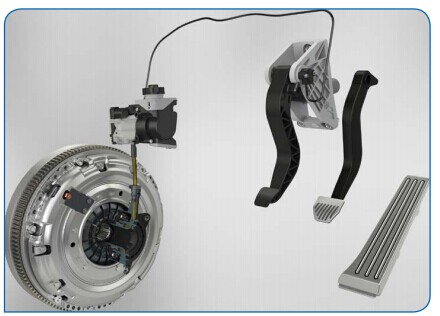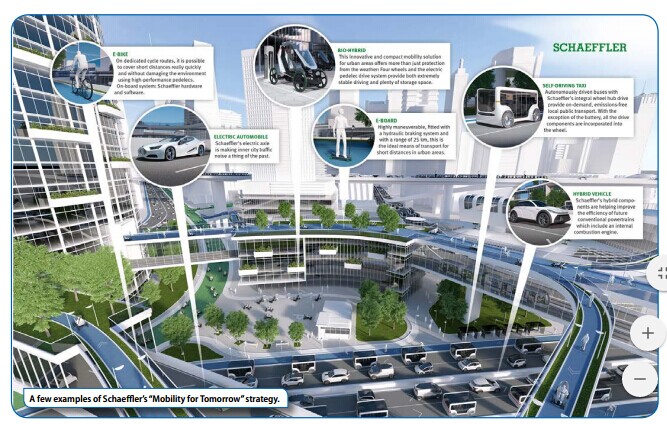
We first heard from Jeff Hemphill, CTO at Schaeffler Group USA Inc., during the CTI Symposium USA that took place May 2016 in Novi, Michigan. Hemphill discussed how Schaeffler was creating an entirely new mobile ecosystem by improving transmission efficiency and noise, vibration and hardness (NVH) testing. Hemphill’s presentation was one of the highlights of the week. Months later, PTE Magazine had an opportunity to further discuss the automotive industry, mechatronics and Schaeffler’s unique role in creating these new mobile ecosystems.
Complete Mechatronic Solutions During CTI, Hemphill talked about looking at potential technologies in new ways by “rearranging” the components in automotive systems. He believes Schaeffler is in a unique position in the mechanical power transmission market to accomplish this.“We make everything from washers to complete mechatronic solutions. We come at it from a very unique perspective in that we really understand all the details and exactly how everything comes together at the system level. This allows us to put things together in different ways,” Hemphill said.
One example is the company’s EClutch for manual transmissions in Europe. Hemphill said that one of the greatest challenges in automobile applications is to hybridize a manual transmission because the computer never knows exactly what the human driver is going to do. With the E-Clutch, the company created a product where a human is driving and operating the clutch, but the computer can also operate it.
Depending on the development stage, the new E-Clutch system either operates the clutch only under specific driving situations, or completely automates all clutch operations. This enables fuel saving driving strategies, from “sailing” to electrically supported driving, to be integrated into vehicles with manual transmissions.
In the automotive market, Hemphill says that everything for a supplier comes down to saving fuel or saving money.
“This is where things are really changing in terms of shared ownership. Vehicles are used more like in fleets than sitting in people’s garages. The hours of usage go up which really changes the TCO (total cost of ownership) for the fleet owner,” he said.
This opens the door for new solutions, like the adoption of battery-electric vehicles. “When you have a steady,relatively cheap electricity supply and you eliminate the maintenance issues that come with combustion engines and transmissions, it pays for itself faster than a commuter. In that picture, mechatronics are very important,” Hemphill added.
He also believes autonomy is going to play a large role in our shared mobility future. “For an autonomous vehicle to work, it’s going to need control of everything in the vehicle. That means you need many more actuators, everything that is moving will become mechatronic in some way,” Hemphill said.
The Importance of E-Mobility
In 2011, the company had a lot of activity in both the automotive and industrial sectors that focused on renewable energy or electric or hybrid vehicles.
“We wanted to bring that detailed knowledge together so we could addsome resources, restructure some others and try to generate some new solutions,” Hemphill said. “We formed our E-Mobility Systems Division as a result.”

Schaeffler’s 48-volt hybrid module provides a point of entry into hybridization and offers potential for reducing CO2 emissions.
Schaeffler engineers took out the conventional powertrain from a vehicle and put in flexible hybrid and electrical architecture. They were able to study in one vehicle, electric wheel motors, electric axles, and also a range extender with a combustion engine in the same car.
“It was basically a rolling laboratory. It was a way to study the advantages and disadvantages of different types of technology. It’s the systematic approach that we’re taking with E-Mobility,” Hemphill said.
Many of the technologies first used in this rolling laboratory are now Schaeffler products. The wheel motors, for example, are now on their third generation.
“We’re convinced there is real potential for wheel motors when we start seeing more RoboCab (autonomous taxi services) that companies like Google and others are working on,” Hemphill said. “When a vehicle’s job is to operate at low-speeds in congested cities, it’s helpful to have a small vehicle and put the powertrain into the wheels. This will free up space for passengers or storage.”
Electric and Hybrid Challenges
Hemphill believes the potential and flexibility of hybrid and electric vehicles from an engineering standpoint is pretty easy to take advantage of. “The issue is largely battery cost,” Hemphill said. “Schaeffler has come up with a couple of things to combat these costs.”
One idea is Schaeffler’s hybrid module. It’s an electric motor with a disconnect clutch and a damper, all built into an aluminum housing that you can bolt in-between a conventional engine and transmission.
“This makes the vehicle a hybrid, to gether with power and batteries. You don’t have to develop a purpose-built engine for your hybrid vehicle which can save you hundreds of millions of dollars. We have two in production right now and the next generation is entering production over the next several years,” Hemphill said.

The active roll control system compensates movements in an automobile chassis caused by driving around corners or on uneven road surfaces.
Schaeffler is also working on how to make better use of the car battery. The company has a number of solutions including a 48-volt mild hybrid for automatic transmission (similar to the manual). Here, a 48-volt motor generator is connected inside the transmission giving a lot more flexibility than the usual solution which is typically putting it on the belt drive where it has to turn with the engine.
“We connected this to the transmission and that means it’s also directly connected to the road,” Hemphill said. “When you’re coasting or slowing the vehicle down you can collect all of that kinetic energy directly into the batteries which you can’t do with a belt starter alternator because you have to use some of it to crank over the engine. It’s better in that respect and it also can do more with a smaller battery.”
Additionally, they connected all the accessories to that motor generator. So items such as the air conditioning, transmission oil pump, vacuum pump and water pump can also be driven from the road when the vehicle is slowing down. That means that you’re recovering energy mechanically as well as electrically. “It’s reconfiguring the system to make the most use of the energy available in the vehicle with the least amount of cost,” Hemphill said.

Depending on the development stage, the new E-Clutch system either operates the clutch only under specific driving situations, or completely automates all clutch operations.
Learning from the Past, Preparing for the Future
Another interesting development from Schaeffler is the company’s electromechanical anti-roll stabilizer. “This is basically an anti-sway bar that we cutapart in the middle and put in a brushless DC motor with a three-stage planetary gear set allowing us to not just passively control the vehicles roll but also actively,” Hemphill said.

The active roll control system compensates movements in an automobile chassis caused by driving around corners or on uneven road surfaces. When combined with intelligent wheel bearings, a high-accuracy satellite navigation system and a communications module, it may, in the future, be possible to produce a real-time image of the condition of the road. This could then be used to send information to vehicles following behind or to the infrastructure operator.
If a vehicle is going around the corner and wants to lean to the outside, this enables the vehicle to push back and straighten out. “That’s a good performance advantage, in the autonomous space, and it reinforces what we learned many years ago. The more disengaged the driver is to the operation of the vehicle, the more every small disturbance disturbs them,” Hemphill said.
First, some history on these changing technologies: This goes back 15 to 20 years ago when Schaeffler introduced some automatically shifted manual transmissions in Europe. It was a great solution from a cost perspective, easy to implement, use an existing transmission and it made the manual transmission behave like an automatic. “We developed the system to the point that the computer could shift far more quickly and smoothly than a human,” Hemphill said.
“But the problem was the driver no longer knew when the vehicle was going to shift. In a manual, you have to interrupt the engine torque in order to select a new gear, so the computer would open the clutch, the vehicle would stop accelerating for a fraction of a second and the driver and passengers weren’t expecting it. They didn’t like it at all. We’ve used the tech in other applications, like dual clutch transmission but no longer in automated manual transmissions.”
Fast forward to autonomous vehicles, you can imagine that’s 10-times worse. “Now, the driver is not even holding the steering wheel anymore. So every little pothole, speed bump, certainly no shifting would be tolerated so things like roll control (which can be used to hold the wheel up, for example, are going to become more and more important now that the driver and passengers are so disengaged,” Hemphill said.
These technologies reinforce Schaeffler’s “Mobility for Tomorrow” strategy and the company’s desire to expand its R&D efforts with an emphasis on digitization.
“The future is going to be complicated in our business,” Hemphill said. “I believe the automotive industry will be a mixture of shared and personal ownership of vehicles and personally-driven versus autonomous. All of these solutions are going to exist on our roads side-by-side.”

 Industry News
Industry News



